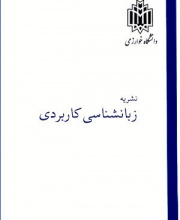
زبان شناسی کاربردی - Iranian Journal of Applied Linguistics
Iranian Journal of Applied Linguistics (IJAL) Vol. 24, No. 1, March 2021 (مقاله علمی وزارت علوم)
مقالات
حوزه های تخصصی:
The identification of the cognitive, affective, social and even physiological factors affecting second or foreign language learning routes and rate has for long been a challenging aspiration for second language researchers. However, a recent preoccupation of the researchers in this area has been the study of the combinatorial impacts of such factors on second or foreign language learning processes and products. As a partial undertaking in this regard, this study investigated the relations pattern among some psychological and cognitive variables and foreign language learning achievement rate. The studied factors were self-regulation, goal-orientation, tolerance of ambiguity, and autonomy on the one hand and English as Foreign Language (EFL) learners’ ultimate achievement on the other hand. To this end, 250 Iranian BA level EFL students majoring English literature or English translation were selected based on convenience sampling procedure. Next, having obtained the participants' informed consent to participate in the study, the researchers administered Trait Self-Regulation Questionnaire (TSRQ), Goal Orientation, Tolerance of Ambiguity, and Learner Autonomy scales to them. In addition, concerning their L2 achievement rate measure, their BA level general English courses' GPA was obtained from the education office of the related universities. The data were statistically analyzed and the hypothetical model of interrelations among the given variables was tested using Structural Equation Modeling procedures. The results indicated that goal orientation and self-regulation significantly predicted L2 achievement; however, tolerance of ambiguity and learner autonomy were not found as strong predictors of L2 achievement. On the other hand, while self-regulation strongly predicted goal orientation, it was not verified to be a strong predictor of tolerance of ambiguity. The results also showed that goal orientation could strongly predict learner autonomy. A ready-made implication of the findings might be that the combinatorial effects of the psychological variables on cognitive processes like second language learning is quite complicated and different from the effects of each individual variable.
Role of L1 and L2 in the Organization of Iranian EFL Lived Narratives(مقاله علمی وزارت علوم)
حوزه های تخصصی:
People are constrained by their culture and social life when telling stories. A second language learner then cannot be expected to tell stories in the target language without cross-cultural effects that influence the way of narration. The present study examined the role of the first language (L1) and second language (L2) in the organization of narratives by focusing on Persian speakers’ and EFL learners’ lived narratives. For this purpose, 125 oral stories were voice recorded. Seventy-five EFL learners’ narratives and 50 Persian narratives as told by Iranian native speakers were collected via classroom discussions and interviews. To examine the substantive effect of L2 knowledge, the EFL learners were selected from pre-intermediate and upper-intermediate proficiency levels. The Labovian analytical narrative model was employed for the analysis. The findings indicated that EFL learners’ narratives were mostly affected by L1 rather than L2. Furthermore, English linguistic knowledge, rather than the English narrative structure itself, affected the organization of EFL narratives
The Relationship between Selective Attention and Simultaneous Interpreting Performance in Undergraduate Students of Translation(مقاله علمی وزارت علوم)
حوزه های تخصصی:
Complexity of simultaneous interpreting has long attracted the interest of researchers and led them to explore different linguistic, psychological, cognitive, social, and neurological factors involved in enabling the human mind to perform such a difficult task. Within the framework of cognitive studies of interpreting, the authors of this study aimed at exploring the relationship between selective attention and interpreting performance of undergraduate students of Translation. Interpreting performance was evaluated in terms of content and presentation. A sample of 72 BA students participated in the study and completed a simultaneous interpreting and a selective attention task. Quantitative analysis of the data obtained from the participants led to the conclusion that selective attention had a direct relationship with both content and presentation of simultaneous interpreting performance in the sample as significant correlation was found to exist between the variables. The findings suggest that students with better selective attention are likely to perform better in interpreting tasks, especially in terms of the content of their performance which is concerned with completeness and accuracy of informational content of the interpreted message.
A Critical Micro Evaluation of the English Language Program Reforms in State Schools: A Language-in-Education Policy and Planning Study(مقاله علمی وزارت علوم)
حوزه های تخصصی:
Writing Formative Assessment for IELTS Preparation Courses: Investigating Iranian Teachers’ Knowledge and Beliefs(مقاله علمی وزارت علوم)
حوزه های تخصصی:
IELTS preparation courses have gained significant popularity in Iran in the past decade. Although teachers in such an exam-oriented context have started to use formative assessment to improve their writing instruction, their knowledge and beliefs about assessment for learning are still a myth. This mixed-methods study investigated Iranian IELTS teachers’ beliefs and knowledge about the four main aspects of formative assessment of writing in preparation courses for IELTS Writing task 2. Thirty-nine IELTS teachers provided answers to a 23-item questionnaire focusing on four areas: feedback, self-assessment, peer-assessment, and using assessment results for day-to-day classes, to illustrate how frequently they use such techniques. In the next stage, six of the teachers sat for an interview to provide their reasons for using/not using such techniques. The results showed that the teachers have good feedback literacy and make use of some self-assessment techniques such as rubric orientation while they did not value or know enough about how they can involve their students in their own learning process. The teachers seemed to overestimate their role in their students’ learning process while considering the students as somewhat incapable of monitoring their own progress and achievement, which is a crucial aspect of formative assessment. These findings have implications for teacher professional development and further formative assessment programs to be conducted in Iran.